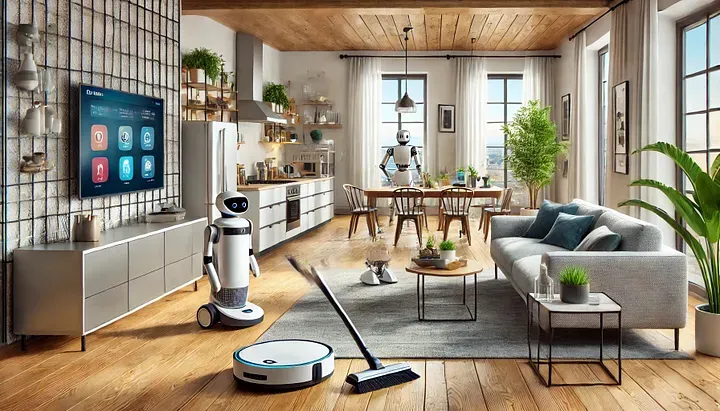How AI Can Be Used in Household Robotics

Artificial intelligence, a transformative force in numerous fields, is now making its mark in household robotics. The integration of AI into everyday household tasks holds the promise of a future where our homes are more innovative, efficient, and convenient. This essay delves into the potential of AI to revolutionize household robotics, showcasing various applications and the benefits they can bring, inspiring a hopeful vision of the future.
One of the most visible applications of AI in household robotics is smart cleaning robots, particularly robotic vacuum cleaners. These devices, powered by AI algorithms, not only map out a home’s layout and identify obstacles but also continuously learn and adapt. They can distinguish between different types of dirt and adjust their cleaning modes accordingly, providing a thorough and efficient cleaning experience that improves over time.
AI-driven personal assistant robots are gaining popularity in homes, and for good reason. These robots, capable of performing a wide range of tasks, from managing schedules to controlling smart home devices, are designed to provide personalized assistance. They use natural language processing (NLP) to understand and respond to spoken commands, making interactions seamless and intuitive. With AI, these robots can learn user preferences and habits, offering personalized assistance that significantly enhances daily living.
AI-powered household robots also play a crucial role in home security. These robots, equipped with advanced cameras and sensors, can patrol the house, detect unusual activities, and alert homeowners or authorities in case of a security breach. AI algorithms analyze real-time video feeds, identifying potential threats and minimizing false alarms. This not only enhances the home’s safety but also provides homeowners peace of mind.
As the global population ages, the demand for elderly care is increasing. AI-enabled household robots can assist the elderly by providing medication reminders, monitoring health parameters, and even offering companionship. These robots can detect emergencies, such as falls, and promptly alert caregivers or medical professionals. By integrating AI, these robots can learn the routines and preferences of their users, providing tailored support that improves the quality of life for older people.
AI-driven robots are making their way into kitchens, helping with cooking and food preparation. These robots can follow recipes, measure ingredients, and even precisely cook meals. AI algorithms allow them to adjust cooking times and temperatures based on the specific dish, ensuring perfect results every time. Additionally, some AI kitchen assistants can suggest recipes based on available ingredients, making meal planning more accessible and efficient.
Household robots equipped with AI can also handle various maintenance tasks. For example, robots can monitor home systems like HVAC (heating, ventilation, and air conditioning) and perform routine checks to ensure everything functions properly. AI can predict when maintenance is needed, preventing costly breakdowns and extending the lifespan of home appliances. By automating these tasks, homeowners can save time and reduce the hassle of maintaining their homes.
In addition to practical tasks, AI-powered household robots can provide entertainment and companionship. These robots can play games, tell stories, and even converse with family members. Advanced AI allows them to understand and adapt to users’ emotional states, offering companionship that can be particularly valuable for individuals living alone. This application of AI in robotics enhances the quality of life and addresses the growing issue of social isolation.
Integrating AI into household robotics transforms our homes into innovative, efficient, and interactive environments. From cleaning and security to elderly care and entertainment, AI-driven robots enhance the convenience and quality of daily living. As technology advances, we can expect household robots to become even more capable, offering new levels of assistance and making our homes truly intelligent. The future of household robotics, powered by AI, promises unprecedented benefits, revolutionizing how we live and interact with our homes.
Join Us Towards a Greater Understanding of AI
By following us and sharing our content, you’re not just spreading awareness but also playing a crucial role in demystifying AI. Your insights, questions, and suggestions make this community vibrant and engaging. We’re eager to hear your thoughts on topics you’re curious about or wish to delve deeper into. Together, we can make AI accessible and engaging for everyone. Let’s continue this journey towards a better understanding of AI. Please share your thoughts with us via email: marty@bearnetai.com, and don’t forget to follow and share BearNetAI with others who might also benefit from it. Your support makes all the difference.
Thank you for being a part of this fascinating journey.
BearNetAI. From Bytes to Insights. AI Simplified.
Categories: Artificial Intelligence (AI), Technology and Innovation, Home Automation, Elderly Care and Assistance, Smart Home Solutions, Future of living
The following sources are cited as references used in research for this BLOG post:
Robotics: Everything You Need to Know About Robotics from Beginner to Expert by Peter Mckinnon
Smart Homes for Dummies by Danny Briere and Pat Hurley
The Fourth Industrial Revolution by Klaus Schwab
Artificial Intelligence: A New Synthesis by Nils J. Nilsson
Clean Architecture: A Craftsman’s Guide to Software Structure and Design by Robert C. Martin
© 2024 BearNetAI LLC